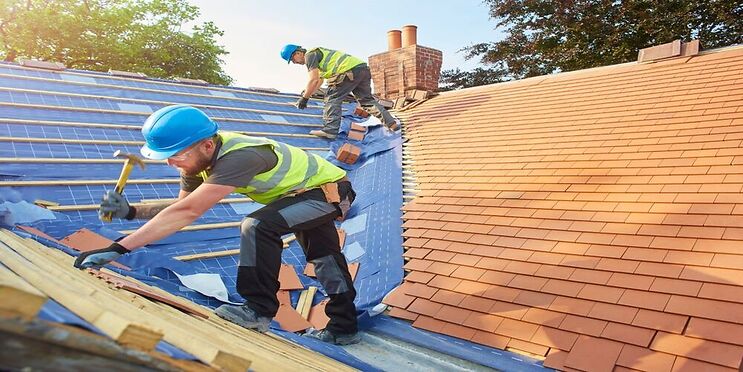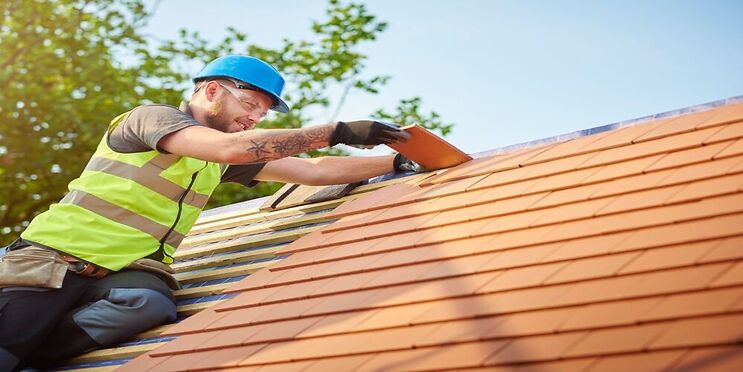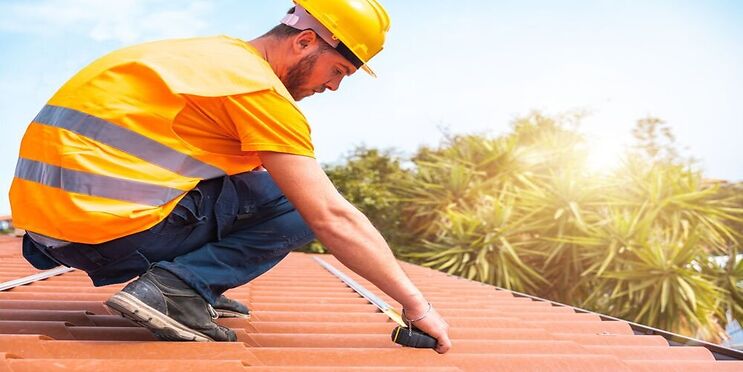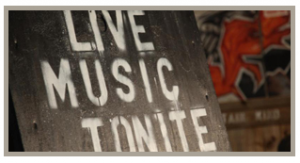Safety Tips For Roof Restoration
Things you need to know to ensure safety on your next roofing project

Roofs are dangerous places. They’re exposed to extreme weather conditions, heavy winds, lightning strikes, falling debris, and other hazards. But roofing materials are designed to withstand these dangers. So why does it still happen?
Last year, our restaurant roof was replaced and a worker was injured, so we decided to put together an article to hopefully raise awareness on roof safety.
Because roofs need to be built properly, and when they’re not made correctly, they fail catastrophically. The result? Huge insurance claims, significant property damage, and personal injury.
That’s why roof safety should be a top priority for homeowners. To protect themselves and their families, they need to understand the risks associated with roof failure and take steps to prevent them.
Here are some precautionary measures to keep in mind when building a safe roof:
Common hazards to watch out for
Fall Hazards
Fall hazards are dangerous and should always be avoided. However, there are ways to prevent falls from happening. First, you should only climb onto roofs with proper equipment. Second, you should only climb onto roofs during daylight hours. Third, you should wear appropriate clothing and footwear. Fourth, you should inspect the roof regularly. Finally, you should call a professional if you notice any problems. These tips will keep you safe and help you avoid falling off roofs.
Power Tools
Power tools are dangerous! The use of electrical tools should always be supervised. To prevent accidents like these, OSHA requires employers to ensure workers are protected from falling objects. Always keep these items locked away and out of sight. Never operate without proper training and supervision. Do not attempt to repair or modify yourself. Always wear eye protection and ear protection. Keep children and pets away from all equipment. Never use use tools near water sources. Also do not operate near flammable hazards like gasoline, paint thinner, etc. Always read and follow the manufacturer’s instructions.
Electricity
Electricity is dangerous. It’s not just because it can kill you. It’s also costly to fix when it does. So be careful where you put electrical outlets and extension cords. And keep them out of reach of children and pets.
If you install an outlet near a ladder, ensure there’s no danger of falling off the ladder. Also, avoid installing outlets next to windows or doors. These locations are prone to drafts that can cause fires.
And finally, never use extension cords unless you need them. They’re cheap and convenient, but they’re also dangerous. So instead, use only those extension cords specifically designed for power tools.
Hazardous chemicals
Hazardous chemicals are dangerous substances that could harm your health if ingested or inhaled. Roofs are especially vulnerable to hazardous chemicals because they are exposed to the elements and may contain leaks. These chemicals can seep into the ground below, causing damage to nearby properties.
To avoid roof problems, always read labels and follow manufacturer instructions. Wear protective gear, gloves, goggles, and boots when working on roofs. Never climb onto roofs unless you are trained to do so safely. Keep children and pets indoors during rainstorms.
Extreme temperatures
Extreme weather conditions pose a risk to roofers who climb onto roofs during extreme heat or cold. When working outside, roofers must protect themselves against the elements.
It’s also important to remember that roofing is dangerous work. Roofs are exposed to wind, rain, snow, ice, and debris, which can lead to injury. As a result, roofers should always seek professional training and follow industry guidelines to prevent accidents.
Personal Protective Equipment for Working on a Roof

Apart from using the neccesary safety equipment, wearing appropriate PPE is a must.
Personal protective equipment (PPE) is any safety gear workers wear to protect themselves against hazards. These include chemicals spills, electricity, fire, water damage, and falling objects.
Many different kinds of PPE are available, depending on the job you’re working on.
- Hard hats
- Earplugs
- Goggles
- Gloves
- Boots
- Respirators
- Safety harness
- Install Scaffolding
- Safety ropes
These items are necessary for anyone working on a construction project, especially if they’re working on a high-rise building. However, these items are only sometimes required by law. Depending on your state, you may only need to wear certain types of PPE.
Roofing Safety Tips
Wear Proper Shoes
Wearing proper shoes is essential for safe climbing up and down ladders. OH & S recommends wearing boots or sneakers with non-slip soles. They should fit snugly and provide support.
It is also recommended that you wear gloves to prevent slipping. Gloves should cover the knuckles and fingers and protect against cuts and scrapes.
Use Ladder Guards
Using ladder guards is another effective way to prevent falls from roofs. Ladder guards are designed to prevent falls from ladders. They come in various shapes and sizes.
They can be made of metal, plastic, wood, or rubber. Some models are adjustable to accommodate different heights. For example, ladder guards can be attached directly to the side rails of a ladder or placed over the top rungs.
Stay Alert
Stay alert while working on roofs to reduce risk of injury. Always pay attention to your surroundings. Avoid distractions such as talking on cell phones or listening to music.
Make sure you know of potential hazards, such as loose shingles, nails protruding from boards, or debris near the roof’s edge.
Be Aware of Weather Conditions
Weather conditions play an essential role in preventing falls from roofs. Rainy weather makes it difficult to see objects and can cause safety issues. Slippery surfaces become slick when raindrops hit them.
Windy days are dangerous because wind gusts can cause ladders to sway back and forth. Wind gusts can also blow away equipment used to secure the edges of roofs.
Take Care of Yourself
One of the most important safety measures is taking good care of yourself.
Get plenty of rest and eat well. Don’t drink alcohol or smoke cigarettes. These habits can impair your judgment and lead to higher risk of accidents.
FAQs

How long should a roof last?
A roof’s lifespan depends on many factors, such as climate, materials, and construction techniques. However, a roof’s typical lifespan ranges from 20 to 30 years. Some roofs may only last 10 years, while others may last 50 years. Most homes built today will require roof replacement within 15 to 20 years. Of course, this is dependent on the type of roof installed. If you live in a region with extreme weather conditions, you may need to replace your roof much earlier than expected. The good news is that you can save money by replacing your roof now rather than later. By having a professional inspect your roof and give you a quote, you can avoid paying thousands of dollars in roof repair costs down the road.
What should I look for in a professional roofer?
There are many factors to consider when choosing a roofing professional and roof restoration services. Some of these include price, experience, reputation, and reviews. However, the most important thing to remember is that you want to hire a professional who knows what they are doing. Plenty of low-cost options are available, but you should only settle for the highest level of service possible. Ask friends and family members for recommendations, check online review sites, and ask around town for referrals. Also, ensure that any roofing services you go for have insurance coverage, workers’ compensation, and liability insurance. These are things you may only realize you need once something goes wrong.
What will a new roof cost?
A new entire roof costs anywhere from $10,000 to $20,000, depending on the size of the house and the type of roof you select. However, if you’re planning to replace your current roof, you should expect to pay around $15,000–$25,000. Also, since roofs last 10 or more years, you could save money by replacing your roof now rather than waiting until later. If you need only small tile or gutter repairs this can start from as little as $500.
Conclusion
In conclusion, if you’re going to restore your roof, you should always perform a roof inspection, including ridge capping, and take safety precautions.
Remember that even though you may be working alone, you still must follow basic safety rules like wearing protective equipment and using ladders correctly.
And when you’re done, make sure to clean everything thoroughly before you leave.
There are many dangers involved with handling a roof without proper training and equipment, such as slipping off the edge of a roof, falling onto power lines, or getting electrocuted.
Even worse, these risks could cause severe injury or death.
So, if you’re planning on tackling a roofing project yourself always follow safety protocols.
However we recommend calling a professional who use certified safety inspectors to ensure everything goes smooothly.


